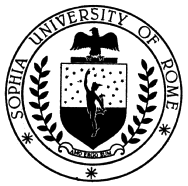
Congresses of the Sophia University of Rome
2005
II° Ulyssiads
Alghero – from July 2 – 9, 2005
Organized by the Institute of Existential Personalistic Anthropology in Tempio Pausania, Sardinia, Italy
Presentation by Antonio Mercurio
The Ulyssiads of the SUR are structured around the following:
a) A part devoted to developing a specific topic;
b) A part devoted to celebration;
c) A part for festivities.
The part devoted to a specific topic:
STUDIES ON THE MYTH OF ULYSSES AND ON THE MYTH OF COSMO-ART,
STUDIES ON THE COSMO-ART THEOREMS AND AXIOMS.
In this first part a specific topic will be elaborated through the presentation of papers on the Myth of Ulysses according to Homer and according to Cosmo-Art.
The part dedicated to celebration:
THEATRICAL REPRESENTATIONS FOR CELEBRATION, CELEBRATION FOR RELIVING.
During this second part one of the thousands of important aspects of the Myth of Ulysses will be represented, according to the indications given by Antonio Mercurio or extracted from his Anthropological, Sophianalytical, Sophiartistic and Cosmoartistic thought that find correlations in Ulysses’ actions.
The part dedicated to festivities:
SONGS AND DANCES TO CELEBRATE THE BIRTH OF COSMO-ART OR TO CELEBRATE OURSELVES.
During this third part we will celebrate Cosmo-Art or a Sophiartistic or Cosmoartistic transformation accomplished by Ulysses or by the Ulysseans.
The Ulysseans can decide to celebrate themselves:
– for how they have grown in their awareness of how to create a bridge between intrauterine and intracosmic life;
– for how they have grown in their concordance between their I and their SELF, between their I and a You, between their I and OTHERS, between their I and the Cosmos, between their conscious I and their profound I;
– for how they have grown in becoming PERSONS in their ability to authentically love themselves;
– for how they have grown as ARTISTS of their own life by having managed to make a synthesis of two opposites;
– for how they have grown as ARTISTS of the life of the Universe by having managed to affirm the organismic principle of Cosmo-Art;
– for how they have grown in having been able to face a conflict by following the guidelines found in the Cosmo-Art Manifesto;
– for having transformed something very painful into a creative action, where overcoming pain becomes an overcoming of death, and overcoming death becomes the creation of lasting and perhaps immortal beauty through time and space.
Antonio Mercurio 2002

